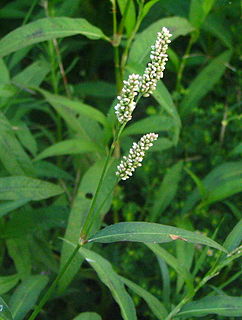
The Polygonaceae are a family of flowering plants known informally as the knotweed family or smartweed—buckwheat family in the United States. The name is based on the genus Polygonum, and was first used by Antoine Laurent de Jussieu in 1789 in his book, Genera Plantarum. The name may refer to the many swollen nodes the stems of some species have, being derived from Greek, poly meaning 'many' and gony meaning 'knee' or 'joint'. Alternatively, it may have a different derivation, meaning 'many seeds'.
Family is one of the eight major hierarchical taxonomic ranks in Linnaean taxonomy; it is classified between order and genus. A family may be divided into subfamilies, which are intermediate ranks between the ranks of family and genus. The official family names are Latin in origin; however, popular names are often used: for example, walnut trees and hickory trees belong to the family Juglandaceae, but that family is commonly referred to as being the "walnut family".

Oleaceae, also known as the olive family, is a taxonomic family of flowering shrubs, trees, and a few lianas in the order Lamiales, It presently comprises 28 genera, one of which is recently extinct. The extant genera include Cartrema, which was resurrected in 2012. The number of species in the Oleaceae is variously estimated in a wide range around 700. The flowers are often numerous and highly odoriferous. The family has a subcosmopolitan distribution, ranging from the subarctic to the southernmost parts of Africa, Australia, and South America. Notable members include olive, ash, jasmine, and several popular ornamental plants including privet, forsythia, fringetrees, and lilac.
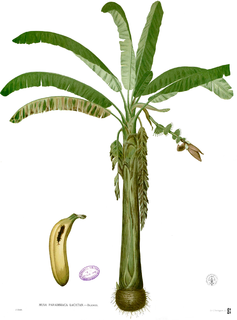
Musaceae is a family of flowering plants composed of three genera with about 91 known species, placed in the order Zingiberales. The family is native to the tropics of Africa and Asia. The plants have a large herbaceous growth habit with leaves with overlapping basal sheaths that form a pseudostem making some members appear to be woody trees. In most treatments, the family has three genera, Musella, Musa and Ensete. Cultivated bananas are commercially important members of the family, and many others are grown as ornamental plants.
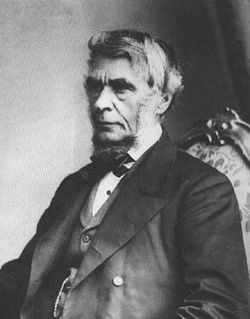
George Bentham was an English botanist, described by the weed botanist Duane Isely as "the premier systematic botanist of the nineteenth century". Born into a distinguished family, he initially studied law, but had a fascination with botany from an early age, which he soon pursued, becoming president of the Linnaean Society in 1861, and a fellow of the Royal Society in 1862. He was the author of a number of important botanical works, particularly flora. He is best known for his taxonomic classification of plants in collaboration with Joseph Dalton Hooker, his Genera Plantarum (1862–1883). He died in London in 1884.

Systema Naturae is one of the major works of the Swedish botanist, zoologist and physician Carl Linnaeus (1707–1778) and introduced the Linnaean taxonomy. Although the system, now known as binomial nomenclature, was partially developed by the Bauhin brothers, Gaspard and Johann, 200 years earlier, Linnaeus was first to use it consistently throughout his book. The first edition was published in 1735. The full title of the 10th edition (1758), which was the most important one, was Systema naturæ per regna tria naturæ, secundum classes, ordines, genera, species, cum characteribus, differentiis, synonymis, locis or translated: "System of nature through the three kingdoms of nature, according to classes, orders, genera and species, with characters, differences, synonyms, places".

Species Plantarum is a book by Carl Linnaeus, originally published in 1753, which lists every species of plant known at the time, classified into genera. It is the first work to consistently apply binomial names and was the starting point for the naming of plants.

Charles Plumier was a French botanist after whom the frangipani genus Plumeria is named. Plumier is considered one of the most important of the botanical explorers of his time. He made three botanizing expeditions to the West Indies, which resulted in a massive work Nova Plantarum Americanarum Genera (1703–1704) and was appointed botanist to King Louis XIV of France.

Pierre Edmond Boissier was a Swiss prominent botanist, explorer and mathematician. He was the son of Jacques Boissier (1784-1857) and Caroline Butini (1786-1836), daughter of Pierre Butini (1759-1838) a well-known physician and naturalist from Geneva. With his sister, Valérie Boissier (1813-1894), he received a strict education with lessons delivered in Italian and Latin. Edmond's interest in natural history stemmed from holidays in the company of his mother and his grandfather, Pierre Butini at Valeyres-sous-Rances. His hikes in the Jura and the Alps laid the foundation of his zest for later exploration and adventure. He attended a course at the Academy of Geneva given by Augustin Pyramus de Candolle.
Ernst Gottlieb von Steudel was a German physician and an authority on grasses.
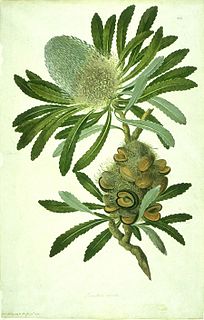
As with other flowering plants, the taxonomy of Banksia has traditionally been based on anatomical and morphological properties of the Banksia flower, fruiting structure and seed, along with secondary characteristics such as leaf structure and growth habit. Increasingly, molecular evidence from DNA is providing important new insights into relationships within the genus and between this and other genera in the Proteaceae.

Olof Peter Swartz was a Swedish botanist and taxonomist. He is best known for his taxonomic work and studies into pteridophytes.

Carl Daniel Friedrich Meissner was a Swiss botanist.
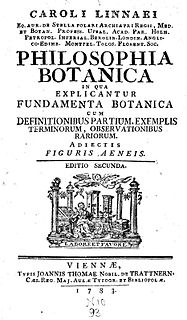
Philosophia Botanica was published by the Swedish naturalist and physician Carl Linnaeus (1707–1778) who greatly influenced the development of botanical taxonomy and systematics in the 18th and 19th centuries. It is "the first textbook of descriptive systematic botany and botanical Latin". It also contains Linnaeus's first published description of his binomial nomenclature.

Genera Plantarum is a publication of Swedish naturalist Carl Linnaeus (1707–1778). The first edition was issued in Leiden, 1737. The fifth edition served as a complementary volume to Species Plantarum (1753). Article 13 of the International Code of Nomenclature for algae, fungi, and plants states that "Generic names that appear in Linnaeus' Species Plantarum ed. 1 (1753) and ed. 2 (1762–63) are associated with the first subsequent description given under those names in Linnaeus' Genera Plantarum ed. 5 (1754) and ed. 6 (1764)." This defines the starting point for nomenclature of most groups of plants.

Critica Botanica was written by Swedish botanist, physician, zoologist and naturalist Carl Linnaeus (1707–1778). The book was published in Germany when Linnaeus was twenty-nine with a discursus by the botanist Johannes Browallius (1707–1755), bishop of Åbo. The first edition was published in July 1737 under the full title Critica botanica in qua nomina plantarum generica, specifica & variantia examini subjiciuntur, selectoria confirmantur, indigna rejiciuntur; simulque doctrina circa denominationem plantarum traditur. Seu Fundamentorum botanicorum pars IV Accedit Johannis Browallii De necessitate historiae naturalis discursus.
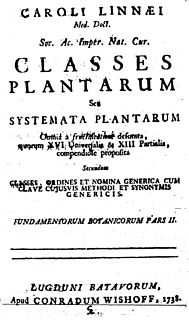
Classes Plantarum is a book that was written by Carl Linnaeus, a Swedish botanist, physician, zoologist and naturalist.

Coryciinae is a subtribe of orchids that has been differently defined and placed in the two classification systems that are currently in use for orchids. Genera Orchidacearum, which is currently the definitive work on orchid taxonomy, delimits Coryciinae as consisting of five genera: Disperis, Evotella, Ceratandra, Pterygodium, and Corycium, and it places Coryciinae in the mostly African tribe Diseae, along with four other subtribes: Brownleeinae, Huttonaeinae, Disinae, and Satyriinae. The genera of Coryciinae are small to medium in size and the number of species in each genus is as follows: Disperis (78), Pterygodium (19), Corycium (15), Ceratandra (6), and Evotella (1).
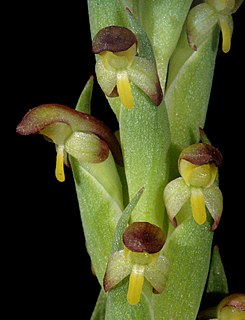
Disinae is a subtribe of orchids that has been differently defined and placed in the two classification systems that are currently in use for orchids. Genera Orchidacearum, which is currently the definitive work on orchid taxonomy, delimits Disinae as consisting of two closely related genera, Disa and Schizodium, and it places Disinae in the mostly African tribe Diseae, along with four other subtribes: Brownleeinae, Huttonaeinae, Coryciinae, and Satyriinae. In the classification for orchids that was published by Chase et alii in 2015, Schizodium was placed in synonymy under Disa, while Pachites and Huttonaea were transferred to Disinae. In Genera Orchidacearum, Pachites and Satyrium form the subtribe Satyriinae, and Huttonaea is the sole genus in the subtribe Huttonaeinae. The transfer of Pachites and Huttonaea to Disinae by Chase et alii (2015) was done with considerable doubt, and was based upon uncertainty about the relationships of these two genera. In 2009, a molecular phylogenetic study found only weak statistical support for a sister relationship between Huttonaea and Disa.

Characteres generum plantarum is a 1775/1776 book by Johann Reinhold Forster and Georg Forster about the botanical discoveries they made during the second voyage of James Cook. The book, which contains 78 plates, introduced 94 binomial names from 75 genera, of which 43 are still the accepted names today.

















